摘要: 依据超声场下形成的空化多泡的形状结构, 建立了两种简化的多泡模型, 即三泡模型和五泡模型, 并利用考虑气泡之间相互作用和液体可压缩性的非线性Keller-Miksis方程, 数值研究了三泡和五泡模型中周围大气泡对中间小气泡空化效应的影响. 结果表明, 在适当条件下随着周围大气泡半径的逐渐增大, 中间小气泡会被完全抑制或会发生延迟膨胀现象. 延迟膨胀的小气泡崩溃时的泡内温度, 当周围大气泡数适当多时, 可以高于相同初始半径的单泡泡内温度. 大小气泡之间的次Bjerknes力在小气泡延迟膨胀时表现为先排斥后吸引, 而正常膨胀大小气泡之间的次Bjerknes力两次都是吸引力.
关键词: 多泡模型 /
延迟膨胀 /
泡内温度 /
次Bjerknes力 English Abstract Influence of large bubbles on cavitation effect of small bubbles in cavitation multi-bubbles Qinghim Naranmandula College of Physics and Electronics, Inner Mongolia University for Nationalities, Tongliao 028043, China Fund Project: Project supported by the National Natural Science Foundation of China (Grant No. 11462019)Received Date: 05 August 2019Accepted Date: 23 September 2019Available Online: 26 November 2019Published Online: 05 December 2019Abstract: In previous papers, researchers generally adopted a simplified assumption that there is a single type of bubble in liquid. In this paper, two simplified bubbles models are established based on the shape and structure of cavitation bubbles formed in ultrasonic field, i.e. linear model consisting of three bubbles and cluster model composed of five bubbles, and each model is assumed to consist of two types of bubbles. The influences of large bubbles on cavitation effect of small bubble in the middle for three- and five-bubble model are numerically studied by using the modified Keller-Miksis equation and van der Waals equation. The changes of the expansion radius of the small bubble in the middle, the temperature in the small bubble and the secondary Bjerknes force between large bubble and small bubble with the increase of the initial radius of large bubbles are mainly investigated. In the calculation, it is assumed that the locations of bubbles stay unchanged and the shape of bubbles remains spherical in the oscillation process. Meanwhile, the time-delay effect on the secondary Bjerknes force can be neglected because the sound wave speed is very fast in water and the bubbles in the liquid can oscillate synchronously. The calculation results show that the expansion of small bubble in the middle can be completely suppressed or delayed when the initial radius and the number of bubbles are appropriate on condition that the distance between large and small bubble, the driving sound pressure and frequency of the applied sound field stay unchanged. The main reason for delayed expansion is that the total pressure acting on small bubbles is delayed to form a negative pressure in the process of the change. The collapse time of delayed expansion of small bubble is basically the same as that of large bubbles, which makes small bubble collapsed rapidly and thoroughly under the strong radiative barotropic effect of large bubble's collapse, and leads the maximum temperature in the small bubble to be higher than that of the single bubble with the same initial radius and the small bubble with normal expansion. In addition, when the expansion of small bubble is delayed, the secondary Bjerknes force between the large bubble and the small bubble appears to be repulsive first and attractive then. This rule is different from the change rule of the secondary Bjerknes force between the two bubbles in normal expansion. The results in this paper have significant theoretical guidance for specific problems such as suppressing liquid cavitation or enhancing liquid cavitation effect by the manual injection of large bubbles.Keywords: multi-bubbles model /delayed expansion /bubble temperature /secondary Bjerknes force 全文HTML --> --> --> 1.引 言 在实际声场中空化泡以空化云的形式存在于液体中, 并且会形成不同的形状结构[1 -4 ] . 这些特殊结构的形成离不开气泡之间的相互作用力, 它主要来自于气泡之间的次Bjerknes力[5 ,6 ] . 因此, 在研究多气泡体系的动力学方程中应该包含反映气泡之间相互作用的耦合作用项. 由于双泡系统是最简单的多泡体系, 所以人们对多泡体系的研究就从双泡系统开始. 文献[7 ]由速度势叠加原理得到双泡的超声空化动力学方程, 并分析了水中空化泡的线度、双泡间距、声压幅值、声波频率等因素对空化过程的影响. 文献[8 ]中研究了双泡相互作用对气泡动力学行为及声辐射频谱的影响. 文献[9 ]利用多气泡模型, 数值研究了液态汞中注入的氦气泡对液态汞中小气泡空化初生的影响. 文献[10 ]在Lighthill方程基础上建立了空化双泡溃灭时流体中的声辐射模型, 并对双泡溃灭及其规律进行了研究. 文献[11 ]利用考虑气泡之间相互作用力的耦合双泡动力学模型, 研究了半径不同的两个空化气泡的空化特性. 文献[12 ]对非球形气泡和球形气泡的相互作用进行了研究, 发现非球形气泡和球形气泡之间的相互作用距离比两个球形气泡的相互作用距离要长的规律.13 ]利用均匀球状泡群的耦合振动模型, 分析了气泡的非线性声响应特征, 气泡空化效应的增强及抑制因素. 文献[14 ]假设气泡大小相同, 建立了线状气泡链和球状气泡群的动力学模型, 分析了气泡链和气泡群中某一气泡的运动行为和声致发光特征. 文献[15 ]联立非线性声波方程和改进的气泡动力学方程, 分析了混合气泡体系中混合气泡与声场的相互作用、气泡之间的相互作用以及声信号频率特性. 文献[16 ]考虑泡群内环境压力的变化对气泡动力学行为的影响, 建立了泡群振动动力学模型并通过数值分析, 发现了泡群内不同初始半径的气泡将同时崩溃现象. 文献[17 ]研究了含混合气泡液体中声波共振传播问题, 发现了含混合气泡液体中声波的共振衰减和共振声速明显变小的基本规律. 文献[18 ]数值研究了环形声源激发声场作用下圆盘内水的空化问题, 提出了可通过温度调节改变液体空化阈值的一种有效方法. 文献[19 ]对超声场中气泡的振动与迁移进行分析, 建立了振动模式选图与气泡初始半径和驱动声压之间的依赖关系. 文献[20 ]对均匀电场中气泡的运动行为进行研究, 揭示了均匀电场对气泡碰撞、合并及上升速度的影响.2.多泡模型及控制方程 22.1.两种多泡模型 2.1.两种多泡模型 在空化多泡声致发光试验中可观察到, 在超声场下形成的空化多泡的大小是不均等的, 且在各方面作用力的平衡下, 形成线状或团状等一些特殊稳定结构. 文献[14 ]研究了线状气泡链模型和球状气泡群模型, 但模型中各气泡的大小都是均等的, 即均匀气泡模型. 然而, 事实证明气泡大小的非均匀性对气泡空化特性的影响是显著而重要的, 所以文献[11 ,12 ]研究了大小不同的两个气泡组成的双泡系统. 双泡系统是最简单的多泡模型, 由于过于简单而有时候不能反映多泡系统的一些重要空化特性. 因此, 本文要建立由三个球形气泡组成的简单线状模型和五个球形气泡组成的简单团状模型(如图1 所示). 在两种模型中忽略了各气泡的空间移动, 即认为气泡中心位置不变并始终保持球形, 中间小气泡的初始半径为$ R_{10} $ , 周围大气泡的初始半径都为$ R_{20} $ , 中间小气泡与周围大气泡之间的距离都是$ D $ . 此模型虽也是较简单的多泡模型, 但对于液体中人工注入几个大气泡来抑制或增强液体空化问题[9 ] , 以及液体中有些小气泡融合形成几个大气泡而影响周围小气泡的空化效应问题[21 ,22 ] 等一些实际问题具有重要的研究意义.图 1 三泡和五泡模型Figure1. Three-bubble model and five-bubble model2.2.控制方程 -->2.2.控制方程 描述可压缩液体中互相之间有相互作用的多气泡体系的动力学方程为(1 )式给出的修正的Keller-Miksis方程[9 ] :$ c $ , $ \rho $ , $ \eta $ 和$ \sigma $ 分别代表液体中的声速、液体密度、黏滞系数和表面张力系数; $ R $ , $ \dot{R} $ 和$ \ddot{R} $ 分别表示气泡的瞬时半径、半径变化率和速度变化率, 下脚标表示第$ i $ 个气泡和第$ j $ 个气泡; $ P_{0} $ 和$ P_{{\rm{s}}, i} $ 为环境压强和泡壁上的压强;$ D_{ij} $ 表示第$ i $ 个气泡和第$ j $ 个气泡中心之间的距离; $ P_{{\rm{ex}}} $ 表示驱动声压. 设气泡内的气体为氩气, 气泡内压强满足van der Waals方程:$ h_{i} $ 为van der Waals硬核半径, 其值为$ h_{i} = $ $ R_{i0}/8.86 $ ; $ R_{i0} $ 为气泡平衡半径. 考虑到气泡壁上的热扩散, 温度可表示为[23 ] $ \gamma $ 和$ \kappa_{{\rm{gas}}} $ 为气体多方指数和气体热扩散系数[23 ] , $ T $ 和$ T_{\infty} $ 分别是泡内温度和环境温度. 第$ j $ 个气泡对第$ i $ 个气泡的辐射压强表示为[6 ] $ D_{ji} = D_{ij} $ , 则第$ i $ 个气泡受到的总压强可以表示为[6 ] $ \langle \; \rangle $ ”表示时间平均值, $ \dot{V_{i}} $ 和$ \dot{V_{j}} $ 分别为球形气泡$ i $ 和$ j $ 的体积变化率, 当$ {F}_{{\rm{B}}} > 0 $ 时次Bjerknes力为排斥力, 反之次Bjerknes力为吸引力.3.大气泡对小气泡空化效应的影响 在三泡和五泡模型中小气泡的初始半径都为$ R_{10} = 4\; {\text{μm}} $ , 大气泡的初始半径$ R_{20} $ 从4 μm开始可逐渐变大, 考虑到两气泡半径之和要远小于两气泡之间的间距, 所以在三泡模型中$ R_{20} $ 计算到40 μm, 五泡模型中$ R_{20} $ 计算到30 μm, 两气泡中心之间的距离为$ D = 150\; {\text{μm}}$ , 驱动声压为$ P_{{\rm{ex}}}(t) = -P_{{\rm{a}}}\; {\sin(2{\text{π}}{f t})} $ . 计算中其他物理参数取为$ P_{{\rm{a}}}\!=\! 1.35 $ atm, $ P_{0} \!=\! 1 $ atm, $ \rho = 1000 $ kg/m3 , $ T_{0} = 293\; {\rm{K}} $ , $ c = 1485 $ m/s, $ \sigma = $ 0.0725 N·m–1 , $ \eta = 0.001 $ Pa·s, $ f = 20 $ kHz.3.1.小气泡膨胀半径的变化 3.1.小气泡膨胀半径的变化 对于大小不同的双泡组成系统的研究已表明, 大气泡对小气泡的抑制作用是很明显的, 且随着大气泡初始半径的增大或双泡之间距离的减小, 大气泡对小气泡的抑制作用越来越强[7 -9 ] . 三泡和五泡模型中情况是否也如此呢? 为此本节研究了周围大气泡和小气泡之间的距离不变时, 随着周围大气泡初始半径的增大,中间小气泡最大膨胀半径的变化情况(如图2 所示). 由图2 可看出, 随着大气泡初始半径的增大, 小气泡最大膨胀半径是“V” 字形变化. 开始时随着大气泡初始半径$ R_{20} $ 的增大, 小气泡最大膨胀半径$ R_{1\max} $ 逐渐减小, 但当大气泡初始半径增大到某一阈值时, 小气泡几乎不能膨胀, 被完全抑制. 随着大气泡初始半径的继续增大, 小气泡的最大膨胀半径开始逐渐增大, 并出现延迟膨胀现象. 为了更详地细分析上述现象, 我们绘制了图3 和图4 . 图3 给出的是在三泡和五泡模型中各气泡初始半径都相同的均匀气泡中中间气泡半径随时间的变化规律, 并与单泡(半径用$ R_{{\rm{s}}} $ 表示)和双泡(半径用$ R_{{\rm{d}}} $ 表示)的半径变化规律进行了比较. 由图3 和图4 可看出, 随着气泡数的增加中间气泡的最大膨胀半径逐渐减少、崩溃时间逐渐延长, 这些特性与文献[13 ,16 ]给出的均匀气泡系统的变化特性相一致. 图4 给出的是大气泡初始半径$ R_{20} $ 取五个特殊值时, 大小气泡半径和单泡的半径随时间的变化规律, 如图4 所示. 从图4 清楚地看到, 大小气泡的初始半径相差不大时(图4(a) ), 它们的膨胀是同步的, 最大膨胀半径的差别也不大, 与相同初始半径的单泡半径变化相比差异也不大, 这是属于气泡的正常膨胀. 随着大气泡初始半径的增大, 小气泡明显受到抑制(图4(b) ). 当三泡模型中大气泡初始半径$ R_{20} = 25\; {\text{μm}}$ , 五泡模型中大气泡初始半径 $ R_{20} = 16\; {\text{μm}}$ 时, 小气泡几乎被完全抑制(图4(c) ). 随着大气泡初始半径的继续增大, 小气泡又开始膨胀起来(图4(d) 和图4(e) ). 但这时小气泡的膨胀与正常膨胀(如图4(a) )不同, 小气泡是在大气泡膨胀最大时开始膨胀并与大气泡几乎同时塌缩, 因此称之为延迟膨胀. 小气泡的膨胀时间与相同初始半径的单泡的膨胀相比较也可看出明显迟缓于单泡的膨胀(图4(d) 和图4(e) ). 在三泡模型中延迟膨胀的最大半径约为30.41 μm, 崩溃时最小半径约为0.58 μm; 在五泡模型中延迟膨胀的最大半径约为34.78 μm, 崩溃时最小半径约为0.52 μm. 值得注意的是小气泡的这种延迟膨胀现象在双泡系统的研究中还没有发现. 这表明, 在三泡和五泡模型中当大气泡的初始半径、大小气泡之间的距离以及外加声场声压和频率合适时, 小气泡可以被完全抑制或可以延迟膨胀. 这一现象在实际液体空化问题中可以得到利用, 如在液体中小气泡附近适当位置人工注入几个适当大的气泡来抑制小气泡的空化膨胀或可以让小气泡延迟膨胀来增强空化膨胀.图 2 小气泡最大膨胀半径随大气泡初始半径的变化Figure2. The maximum expansion radius of small bubbles varies with the initial radius of large bubbles图 3 均匀气泡系统中中间气泡半径随时间的变化曲线Figure3. Radius-time curves of middle bubbles in uniform bubble system图 4 气泡半径随时间的变化曲线Figure4. Radius-time curves of bubbles6 )式计算了小气泡受到的总压强, 如图5 和图6 所示. 图5 所示的是三泡模型中小气泡受到的压强, 可明显看到小气泡是在负压区域膨胀. 这是因为在小气泡附近形成了负压进而对小气泡给了拉应力作用, 使小气泡表面压力平衡受到破坏, 内部压力大于外部压力而导致小气泡的膨胀. 由(6 )式可知, 负压区域的形成主要取决于周围大气泡产生的辐射压和外加声场产生的声压的相对大小. 在图5(c) 中由于大气泡产生的辐射压(绿线)和外加声场产生的声压(蓝线)基本平衡, 在小气泡膨胀区域内受到的总压强(红线)基本为零, 所以小气泡没有膨胀起来也就基本被抑制. 在图5(d) 和图5(e) 中由于大气泡产生的辐射压足够强, 在一个周期内一直压过外加声场而占据主导地位, 并在辐射压的负压区域形成了总压强(红线)的负压区域, 导致了小气泡的延迟膨胀. 图6 所示的是五泡模型中小气泡受到的压强, 容易看到小气泡受到的总压强的变化规律与三泡模型中小气泡受到的总压强的变化规律基本相同, 不同的是由于周围大气泡数量的增多, 产生的辐射压更强, 导致小气泡被压制得更彻底或延迟膨胀得更大些. 另外, 也可看出随着周围大气泡数量的增多, 小气泡被抑制或延迟膨胀时对大气泡初始半径的要求可以明显降低, 这表明合适数量的大气泡更易于对小气泡的抑制或小气泡的延迟膨胀.图 5 三泡模型中小气泡膨胀阶段受到的压强 (a) $R_{20}=5\;{\text{μm}}$ ; (b) $R_{20}=15\;{\text{μm}}$ ; (c) $R_{20}=25\;{\text{μm}}$ ; (d) $R_{20}=35\;{\text{μm}}$ ; (e) $R_{20}=40\;{\text{μm}}$ Figure5. Total pressure acting on growth stage of small bubble in three-bubble model: (a) $R_{20}=5\;{\text{μm}}$ ; (b) $R_{20}=15\;{\text{μm}}$ ; (c) $R_{20}=25\;{\text{μm}}$ ; (d) $R_{20}=35\;{\text{μm}}$ ; (e) $R_{20}=40\;{\text{μm}}$ .图 6 五泡模型中小气泡膨胀阶段受到的压强 (a) $R_{20}=5\;{\text{μm}}$ ; (b) $R_{20}=10\;{\text{μm}}$ ; (c) $R_{20}=16\;{\text{μm}}$ ; (d) $R_{20}=25\;{\text{μm}}$ ; (e) $R_{20}=30\;{\text{μm}}$ Figure6. Total pressure acting on growth stage of small bubble in five-bubble model: (a) $R_{20}=5\;{\text{μm}}$ ; (b) $R_{20}=10\;{\text{μm}}$ ; (c) $R_{20}=16\;{\text{μm}}$ ; (d) $R_{20}=25\;{\text{μm}}$ ; (e) $R_{20}=30\;{\text{μm}}$ .3.2.小气泡内温度的变化 -->3.2.小气泡内温度的变化 在空化多泡系统中某一气泡的泡内温度多少也是人们关心的重要问题. 本节利用文献[23 ] 给出的计算泡内温度的(4 )式, 计算了三泡和五泡模型中中间小气泡的泡内温度. 图7 所示的是小气泡内最高温度随周围大气泡初始半径的变化. 可以看出, 随着周围大气泡初始半径的增大, 小气泡泡内最高温度呈现“U”字形变化规律. 在三泡模型中, 随着大气泡初始半径的增大, 小气泡泡内最高温度开始下降, 最低达到700 K左右后开始缓慢上升. 当小气泡延迟膨胀时泡内最高温度达到14000 K, 接近于小气泡正常膨胀(图4(a) )时泡内最高温度. 在五泡模型中, 随着大气泡初始半径的增大, 小气泡泡内最高温度也开始下降, 最低达到800 K左右后开始上升. 当小气泡延迟膨胀时泡内最高温度接近40000 K左右, 远远高于正常膨胀(图4(a) )小气泡的泡内最高温度(约16000 K), 也高于相同条件下初始半径$ R_{{\rm{s}}} = 4\;{\text{μm}}$ 的单泡的泡内最高温度(约25000 K). 这是因为小气泡崩溃时刻接近于大气泡的崩溃时刻, 因而受到大气泡崩溃时的强大辐射正压, 使小气泡塌缩的更快更彻底, 导致小气泡的泡内温度很高. 从图4(e) 明显可看到, 延迟膨胀的小气泡从开始膨胀到崩溃所用的时间非常短暂, 气泡的径向速度很快, 要远快于正常膨胀气泡崩溃时的速度. 相比两种模型可知, 五泡模型中小气泡泡内最高温度升得更快, 延迟膨胀时达到的泡内温度更高. 当然, 在温度计算时采用的计算模型没有考虑水蒸气、化学反应、质量扩散等很多影响泡内温度的因素, 因此计算得到结果不能完全符合实际温度.图 7 两个模型中小气泡内的最高温度随大气泡初始半径的变化Figure7. The maximum temperature of small bubbles in two models varies with the initial radius of large bubbles3.3.大小气泡之间次Bjerknes力的变化 -->3.3.大小气泡之间次Bjerknes力的变化 次Bjerknes力是相邻气泡之间的相互作用力, 它对气泡的空化特性及其动力学行为产生重要影响. 下面主要在三泡和五泡模型中,考察随着大气泡初始半径的增大, 大小气泡之间的次Bjerknes力的变化. 图8 显示的是三泡模型中大小气泡之间的次Bjerknes力的变化, 可看出周围大气泡和小气泡的大小差异不大时, 在一周期内次Bjerknes力有两次振荡, 都表现为吸引力, 这与文献[11 ]中对双泡模型的研究结果相同. 随着大气泡初始半径的增大, 小气泡慢慢被抑制, 此时次Bjerknes力激烈地交替变化, 幅值相对较小. 随着大气泡初始半径的继续增大, 小气泡开始延迟膨胀, 此时次Bjerknes力开始增强并表现出先排斥后吸引的振荡规律, 最大排斥力约为$7. 46\!\times\! 10^{-5} \;{\rm{N}},$ 最大吸引力约为$ 41.73\times10^{-5} \;{\rm{N}}$ . 图9 显示的是五泡模型中大小气泡之间的次Bjerknes力的变化, 可看出五泡模型中次Bjerknes力的变化规律与三泡模型中次Bjerknes力的变化规律完全类似, 只是在次Bjerknes力的幅值上有所差别. 在五泡模型中, 当小气泡延迟膨胀时最大排斥力约为$ 6.437\!\times\!10^{-5} \;{\rm{N}}$ , 最大吸引力约为$ 39.04\times10^{-5}\;{\rm{N}} $ . 显然, 这数值要小于三泡模型中最大排斥力和最大吸引力, 这是因为在五泡模型中周围大气泡数量较多, 小气泡同时受到多个大气泡的作用, 虽然每个大气泡和小气泡之间的作用力不是很大, 但是合力很大足以使小气泡延迟膨胀起来, 所以五泡模型中次Bjerknes力的最大排斥力和最大吸引力要小于三泡模型中最大排斥力和最大吸引力.图 8 三泡模型中大小气泡之间的次Bjerknes力的变化 (a) $R_{20}=5\;{\text{μm}}$ ; (b) $R_{20}=15\;{\text{μm}}$ ; (c) $R_{20}=25\;{\text{μm}}$ ; (d) $R_{20}=35\;{\text{μm}}$ ; (e) $R_{20}=40\;{\text{μm}}$ Figure8. Changes of secondary Bjerknes forces between large and small bubbles in three-bubble model: (a) $R_{20}=5\;{\text{μm}}$ ; (b) $R_{20}=15\;{\text{μm}}$ ; (c) $R_{20}=25\;{\text{μm}}$ ; (d) $R_{20}=35\;{\text{μm}}$ ; (e) $R_{20}=40\;{\text{μm}}$ .图 9 五泡模型中大小气泡之间的次Bjerknes力的变化 (a) $R_{20}=5\;{\text{μm}}$ ; (b) $R_{20}=10\;{\text{μm}}$ ; (c) $R_{20}=16\;{\text{μm}}$ ; (d) $R_{20}=25\;{\text{μm}}$ ; (e) $R_{20}=30\;{\text{μm}}$ Figure9. Changes of secondary Bjerknes forces between large and small bubbles in five-bubble model: (a) $R_{20}=5\;{\text{μm}}$ ; (b) $R_{20}=10\;{\text{μm}}$ ; (c) $R_{20}=16\;{\text{μm}}$ ; (d) $R_{20}=25\;{\text{μm}}$ ; (e) $R_{20}=30\;{\text{μm}}$ .4.结 论 本文依据超声场下形成的空化多泡的形状结构, 建立了两种简化多泡模型. 利用考虑气泡之间相互作用和液体可压缩性的非线性Keller-Miksis方程, 数值方法研究了三泡和五泡模型中周围大气泡对中间小气泡空化效应的影响, 重点考察了随着周围大气泡初始半径的增大中间小气泡膨胀半径的变化、泡内温度的变化以及大小气泡之间次Bjerknes力的变化. 结果表明, 大小气泡之间的距离和外加声场声压和频率不变的条件下, 当大气泡初始半径和数量取合适值时中间小气泡可以被完全抑制或可以延迟膨胀. 延迟膨胀的主要原因是小气泡受到的总压强在变化中延迟形成了负压区域. 延迟膨胀小气泡的崩溃与大气泡的崩溃时间基本同步, 使得小气泡受到大气泡崩溃时的强大辐射正压作用而小气泡崩溃迅速、彻底, 导致小气泡泡内温度可高于相同初始半径的单泡泡内温度和正常膨胀小气泡的泡内温度. 大小气泡之间的次Bjerknes力在小气泡延迟膨胀时表现为先排斥后吸引, 此规律不同于正常膨胀大小气泡之间的次Bjerknes力的变化规律. 本文结果对通过人工注入大气泡的方式抑制液体空化或液体空化效应的增强等具体问题具有重要的理论指导意义. 


 图 1 三泡和五泡模型
图 1 三泡和五泡模型

































































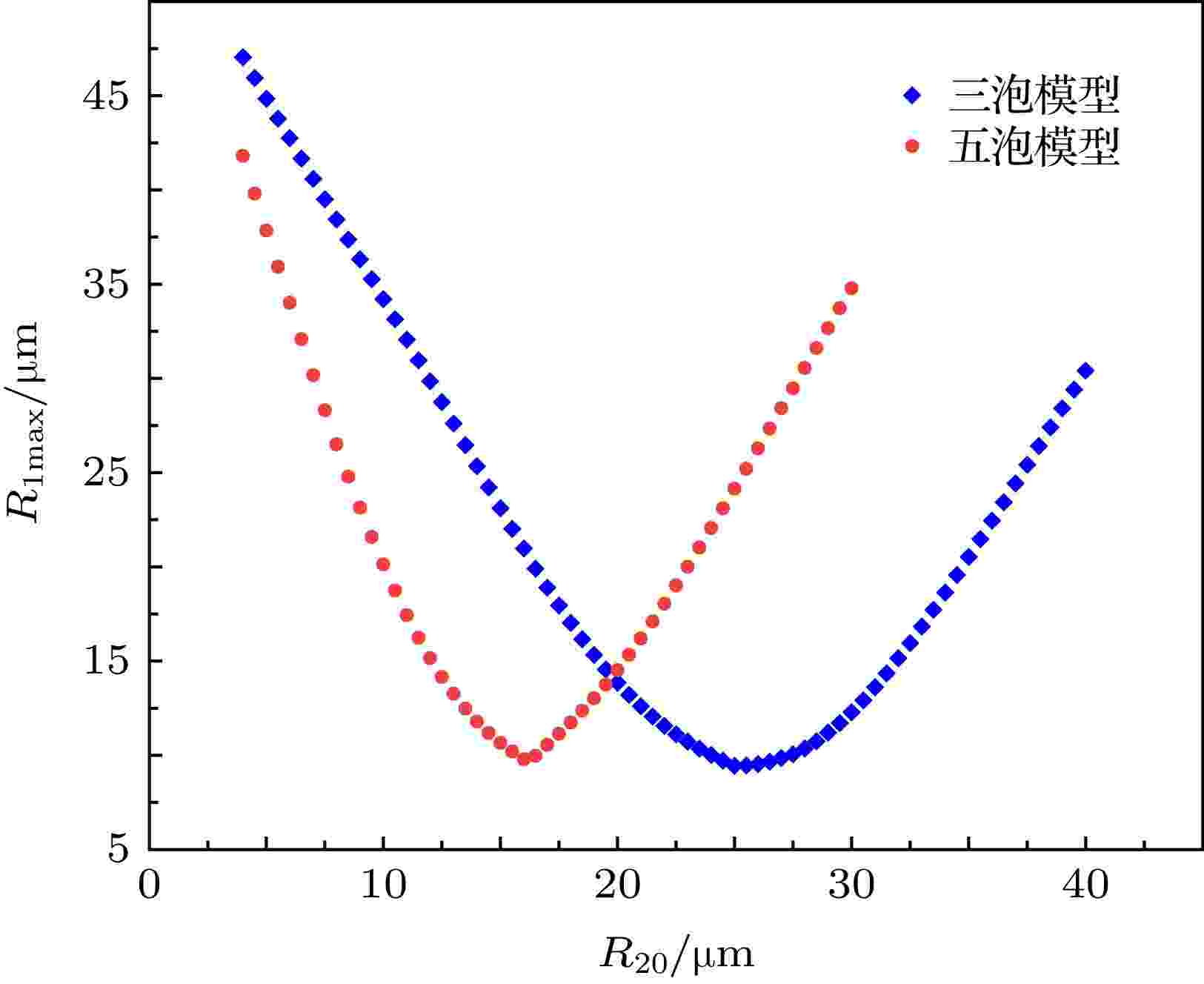 图 2 小气泡最大膨胀半径随大气泡初始半径的变化
图 2 小气泡最大膨胀半径随大气泡初始半径的变化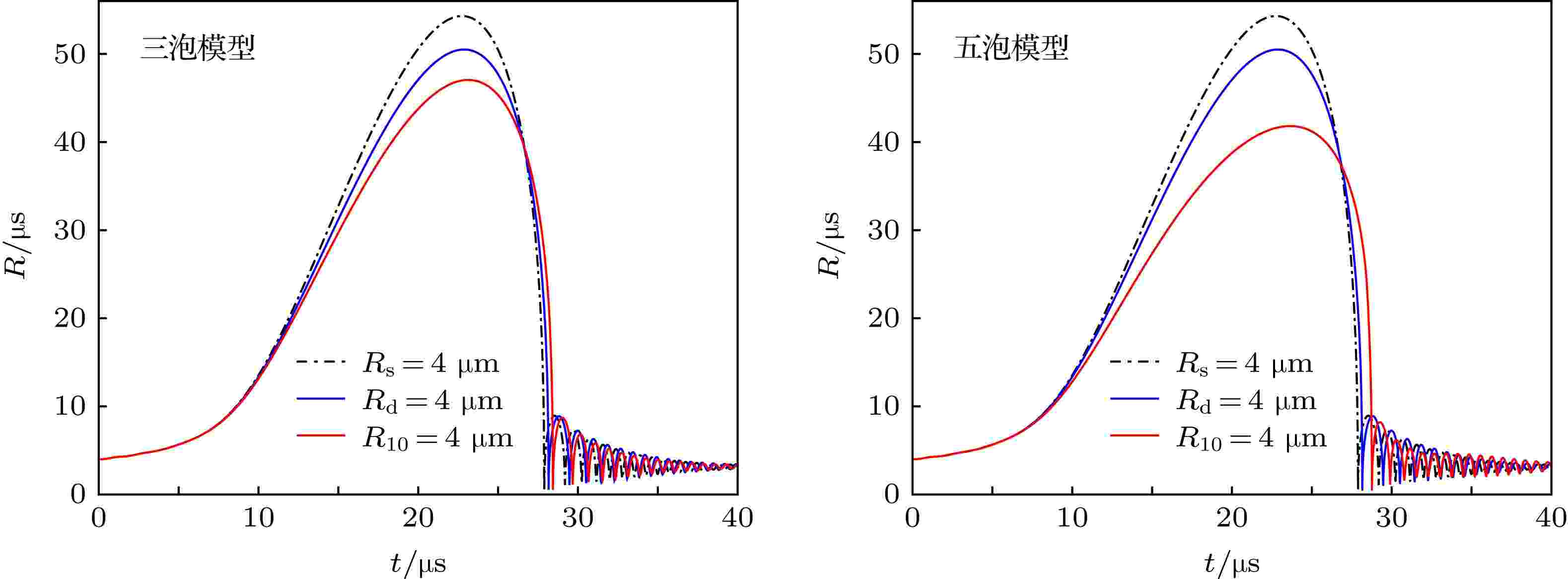 图 3 均匀气泡系统中中间气泡半径随时间的变化曲线
图 3 均匀气泡系统中中间气泡半径随时间的变化曲线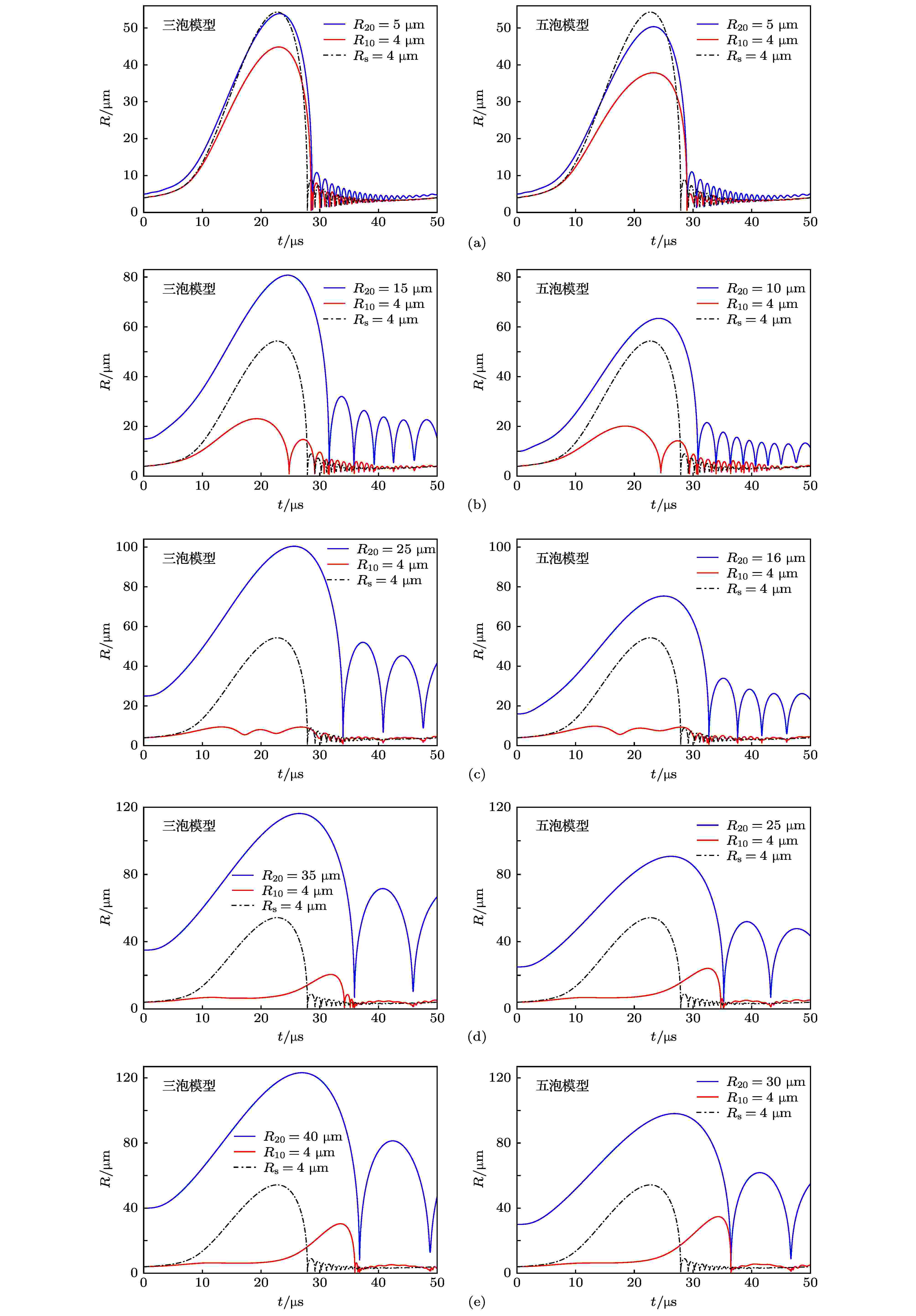 图 4 气泡半径随时间的变化曲线
图 4 气泡半径随时间的变化曲线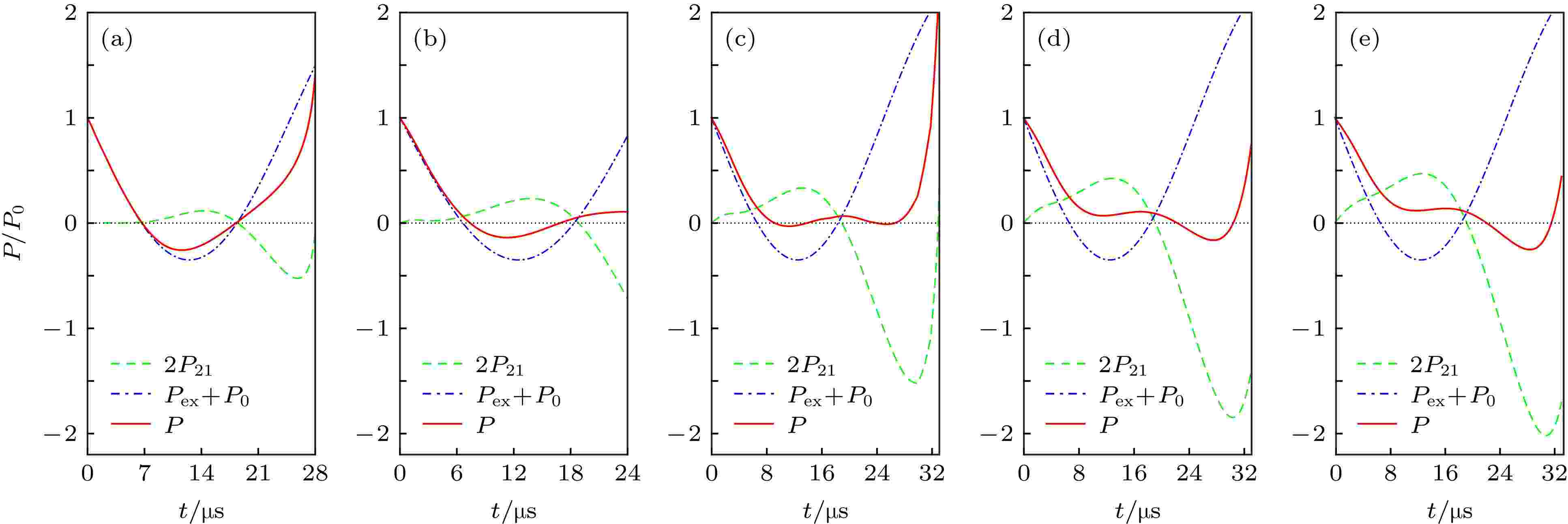 图 5 三泡模型中小气泡膨胀阶段受到的压强 (a)
图 5 三泡模型中小气泡膨胀阶段受到的压强 (a) 









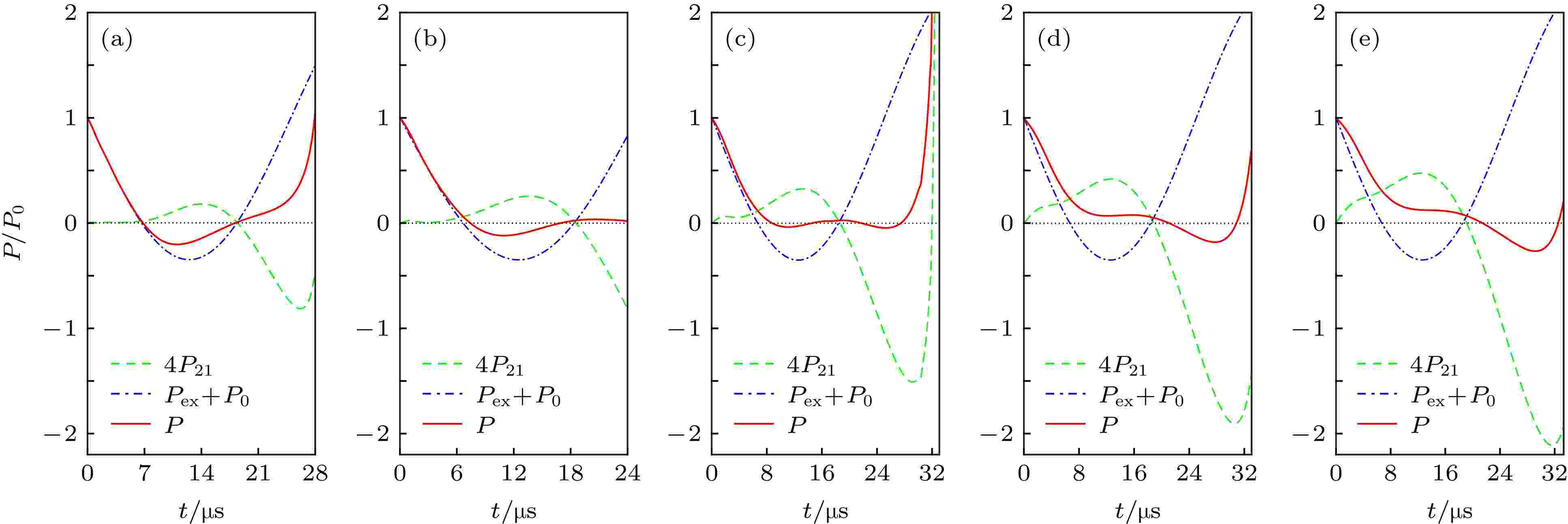 图 6 五泡模型中小气泡膨胀阶段受到的压强 (a)
图 6 五泡模型中小气泡膨胀阶段受到的压强 (a) 










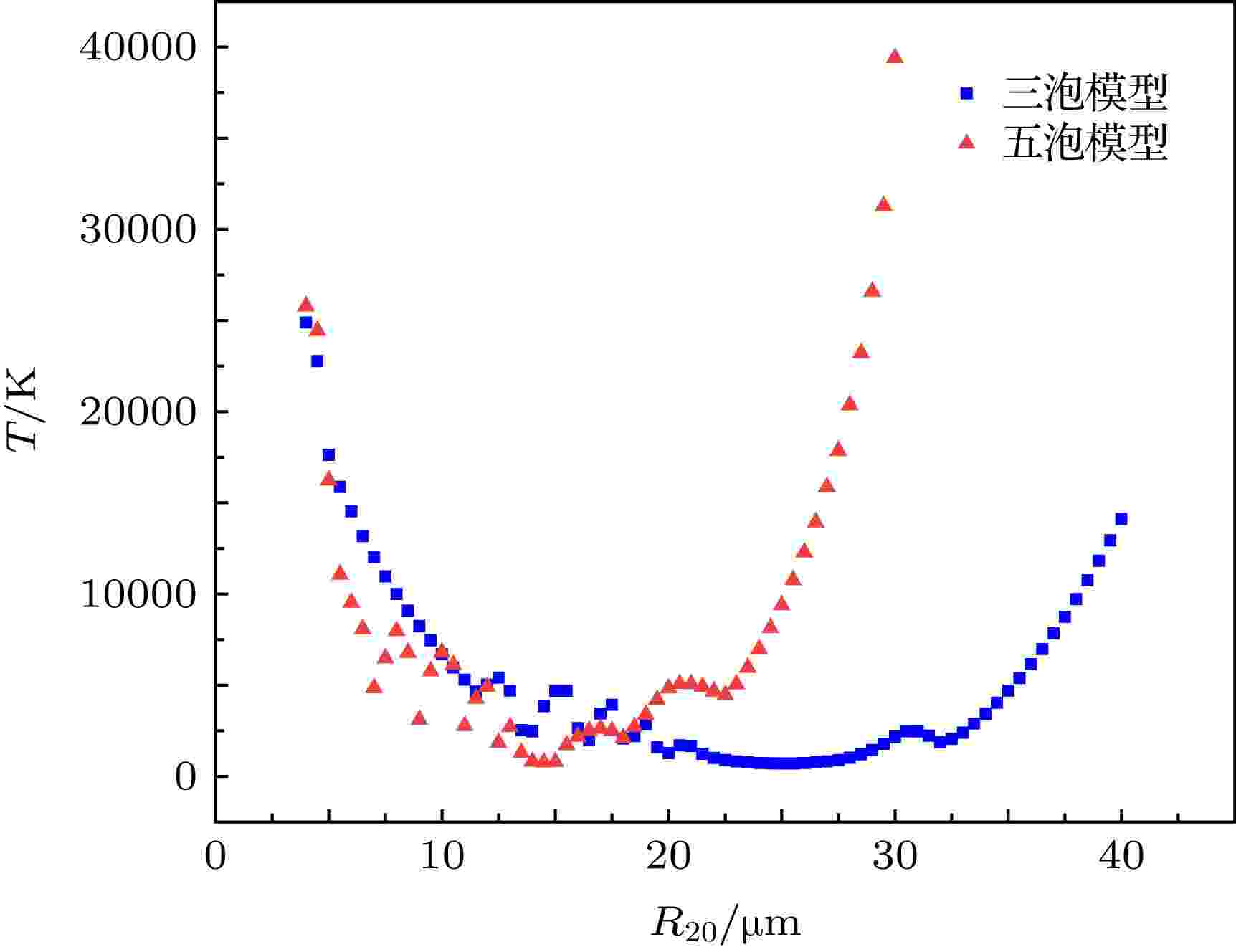 图 7 两个模型中小气泡内的最高温度随大气泡初始半径的变化
图 7 两个模型中小气泡内的最高温度随大气泡初始半径的变化



 图 8 三泡模型中大小气泡之间的次Bjerknes力的变化 (a)
图 8 三泡模型中大小气泡之间的次Bjerknes力的变化 (a) 









 图 9 五泡模型中大小气泡之间的次Bjerknes力的变化 (a)
图 9 五泡模型中大小气泡之间的次Bjerknes力的变化 (a) 









